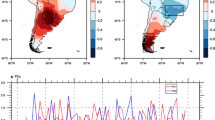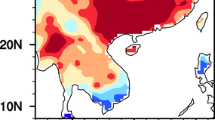Abstract
Recent observations showed that boreal winter exhibits significant cooling events in the Eurasian and North American continents despite the global warming trend. To better understand the boreal winter surface air temperature (SAT) variability and its physical characteristics, we investigated the three distinct Empirical Orthogonal Function (EOF) modes of the extratropical 2-m air temperature (T2m) variation and found that each mode can be related to the well-known physical processes: The first mode is characterized by the coherent change of wintertime SAT anomalies over northern Eurasia and central-eastern North America and it is found that snow cover variation in the Eurasian region can modulate Arctic Oscillation (AO) circulation through the troposphere–stratosphere interaction, which can affect wintertime SAT in the two continents. The second leading mode shows warm anomalies over the North Pacific especially around the Bering Strait and cold anomalies over most of Canada and the central part of North America. Associated with this mode, La Niña-like sea surface temperature (SST) anomaly can modulate the North American SAT variability through the generation of the tropospheric Pacific–North American (PNA) teleconnection pattern. The third mode represents warm anomalies over the Barents and Kara (B–K) seas and cold anomalies over East Asia. Sea ice loss over the B–K sea is analyzed to be closely related to the SAT variability over the East Asian region.









Similar content being viewed by others
Change history
08 February 2021
A Correction to this paper has been published: https://doi.org/10.1007/s00382-021-05629-8
References
Blackport R, Screen JA, van der Wiel K, Bintanja R (2019) Minimal influence of reduced Arctic sea ice on coincident cold winters in mid-latitudes. Nat Clim Change 9:697–704. https://doi.org/10.1038/s41558-019-0551-4
Brown RD, Robinson DA (2011) Northern Hemisphere spring snow cover variability and change over 1922–2010 including an assessment of uncertainty. Cryosphere 5:219–229. doi:https://doi.org/10.5194/tc-5-219-2011
Burridge DM, Källen E (2012) Problems and prospects in long and medium range weather forecasting. Springer, Berlin
Cohen JL, Furtado JC, Barlow MA et al (2012) Arctic warming, increasing snow cover and widespread boreal winter cooling. Environ Res Lett. doi:https://doi.org/10.1088/1748-9326/7/1/014007
Cohen J, Furtado JC, Jones J et al (2014a) Linking Siberian snow cover to precursors of stratospheric variability. J Clim 27:5422–5432. doi:https://doi.org/10.1175/JCLI-D-13-00779.1
Cohen J, Screen JA, Furtado JC et al (2014b) Recent Arctic amplification and extreme mid-latitude weather. Nat Geosci 7:627–637. doi:https://doi.org/10.1038/ngeo2234
Cohen J, Zhang X, Francis J et al (2020) Divergent consensuses on Arctic amplification influence on midlatitude severe winter weather. Nat Clim Change 10:20–29. https://doi.org/10.1038/s41558-019-0662-y
Francis JA, Chan W, Leathers DJ et al (2009) Winter Northern Hemisphere weather patterns remember summer Arctic sea-ice extent. Geophys Res Lett 36:1–5. doi:https://doi.org/10.1029/2009GL037274
Furtado JC, Cohen JL, Butler AH et al (2015) Eurasian snow cover variability and links to winter climate in the CMIP5 models. Clim Dyn 45:2591–2605. doi:https://doi.org/10.1007/s00382-015-2494-4
Gerber F, Sedláček J, Knutti R (2014) Influence of the western North Atlantic and the Barents Sea on European winter climate. Geophys Res Lett 41:561–567. doi:https://doi.org/10.1002/2013GL058778
Hartmann DL (2015) Pacific sea surface temperature and the winter of 2014. Geophys Res Lett 42:1894–1902. doi:https://doi.org/10.1002/2015GL063083.Received
He S, Gao Y, Li F et al (2017) Impact of Arctic oscillation on the East Asian climate: a review. Earth-Sci Rev 164:48–62. https://doi.org/10.1016/j.earscirev.2016.10.014
Honda M, Inoue J, Yamane S (2009) Influence of low Arctic sea-ice minima on anomalously cold Eurasian winters. Geophys Res Lett. doi:https://doi.org/10.1029/2008GL037079
Jaiser R, Dethloff K, Handorf D et al (2012) Impact of sea ice cover changes on the northern hemisphere atmospheric winter circulation. Tellus Ser A Dyn Meteorol Oceanogr 64:0–11. doi:https://doi.org/10.3402/tellusa.v64i0.11595
Kim BM, Son SW, Min SK et al (2014) Weakening of the stratospheric polar vortex by Arctic sea-ice loss. Nat Commun 5:1–8. doi:https://doi.org/10.1038/ncomms5646
Kim KY, Son SW (2016) Physical characteristics of Eurasian winter temperature variability. Environ Res Lett. doi:https://doi.org/10.1088/1748-9326/11/4/044009
King MP, Hell M, Keenlyside N (2016) Investigation of the atmospheric mechanisms related to the autumn sea ice and winter circulation link in the Northern Hemisphere. Clim Dyn 46:1185–1195. doi:https://doi.org/10.1007/s00382-015-2639-5
Kistler R, Kalnay E, Collins W et al (2001) The NCEP-NCAR 50-year reanalysis: monthly means CD-ROM and documentation. Bull Am Meteorol Soc 82:247–267. https://doi.org/10.1175/1520-0477(2001)082<0247:TNNYRM>2.3.CO;2
Kobayashi S, HARADA Y, EBITA A et al (2015) The JRA-55 reanalysis: general specifications and basic characteristics. J Meteorol Soc Jpn Ser II 93:5–48. https://doi.org/10.2151/jmsj.2015-001
Kretschmer M, Coumou D, Donges JF, Runge J (2016) Using causal effect networks to analyze different arctic drivers of midlatitude winter circulation. J Clim 29:4069–4081. doi:https://doi.org/10.1175/JCLI-D-15-0654.1
Kretschmer M, Coumou D, Agel L et al (2018) More-persistent weak stratospheric polar vortex States linked to cold extremes. Bull Am Meteorol Soc 99:49–60. doi:https://doi.org/10.1175/BAMS-D-16-0259.1
Kug J-S, Jeong J-H, Jang Y-S et al (2015) Two distinct influences of Arctic warming on cold winters over North America and East Asia. Nat Geosci 8:759–762. doi:https://doi.org/10.1038/ngeo2517
Kumar A, Perlwitz J, Eischeid J et al (2010) Contribution of sea ice loss to Arctic amplification. Geophys Res Lett 37:2–7. doi:https://doi.org/10.1029/2010GL045022
Lee J-Y, Wang B (1983) Seasonal climate prediction and predictability of atmospheric circulation. Clim Model. https://doi.org/10.5772/33782
Li C, Stevens B, Marotzke J (2015) Eurasian winter cooling in the warming hiatus of 1998–2012. Geophys Res Lett 42:8131–8139. doi:https://doi.org/10.1002/2015GL065327
Luo D, Xiao Y, Diao Y et al (2016) Impact of Ural blocking on winter warm Arctic-cold Eurasian anomalies. Part II: the link to the North Atlantic Oscillation. J Clim 29:3949–3971. https://doi.org/10.1175/JCLI-D-15-0612.1
Mori M, Watanabe M, Shiogama H et al (2014) Robust Arctic sea-ice influence on the frequent Eurasian cold winters in past decades. Nat Geosci 7:869–874. doi:https://doi.org/10.1038/ngeo2277
Nagato Y, Tanaka HL (2012) Global warming trend without the contributions from decadal variability of the Arctic Oscillation. Polar Sci 6:15–22. doi:https://doi.org/10.1016/j.polar.2012.02.001
Overland JE, Wang M (2010) Large-scale atmospheric circulation changes are associated with the recent loss of Arctic sea ice. Tellus Ser A Dyn Meteorol Oceanogr 62:1–9. doi:https://doi.org/10.1111/j.1600-0870.2009.00421.x
Perlwitz J, Hoerling M, Dole R (2015) Arctic tropospheric warming: causes and linkages to lower latitudes. J Clim 28:2154–2167. https://doi.org/10.1175/JCLI-D-14-00095.1
Reynolds RW, Smith TM, Liu C et al (2007) Daily high-resolution-blended analyses for sea surface temperature. J Clim 20:5473–5496. doi:https://doi.org/10.1175/2007JCLI1824.1
Robinson DA, Dewey KF, Heim RR (1993) Global snow cover monitoring: an update. Bull Am Meteorol Soc 74:1689–1696. https://doi.org/10.1175/1520-0477(1993)074<1689:GSCMAU>2.0.CO;2
Screen JA, Simmonds I (2010a) Increasing fall-winter energy loss from the Arctic Ocean and its role in Arctic temperature amplification. Geophys Res Lett 37:1–5. doi:https://doi.org/10.1029/2010GL044136
Screen JA, Simmonds I (2010b) The central role of diminishing sea ice in recent Arctic temperature amplification. Nature 464:1334–1337. doi:https://doi.org/10.1038/nature09051
Screen JA, Simmonds I, Deser C, Tomas R (2013) The atmospheric response to three decades of observed arctic sea ice loss. J Clim 26:1230–1248. doi:https://doi.org/10.1175/JCLI-D-12-00063.1
Screen JA (2017) The missing Northern European winter cooling response to Arctic sea ice loss. Nat Commun 8:1–9. doi:https://doi.org/10.1038/ncomms14603
Screen JA, Deser C, Smith DM et al (2018) Consistency and discrepancy in the atmospheric response to Arctic sea-ice loss across climate models. Nat Geosci 11:155–163. doi:https://doi.org/10.1038/s41561-018-0059-y
Seo KH, Son JH, Lee JY, Park HS (2015) Northern East Asian monsoon precipitation revealed by airmass variability and its prediction. J Clim 28:6221–6233. doi:https://doi.org/10.1175/JCLI-D-14-00526.1
Serreze MC, Barrett AP, Stroeve JC et al (2009) The emergence of surface-based Arctic amplification. Cryosph 3:11–19. doi:https://doi.org/10.5194/tc-3-11-2009
Sun L, Perlwitz J, Hoerling M (2016) What caused the recent “Warm Arctic, Cold Continents” trend pattern in winter temperatures? Geophys Res Lett 43:5345–5352. doi:https://doi.org/10.1002/2016GL069024.Received
Tachibana Y, Komatsu KK, Alexeev VA et al (2019) Warm hole in Pacific Arctic sea ice cover forced mid-latitude Northern Hemisphere cooling during winter 2017–18. Sci Rep 9:1–12. doi:https://doi.org/10.1038/s41598-019-41682-4
Vihma T (2014) Effects of Arctic Sea ice decline on weather and climate: a review. Surv Geophys 35:1175–1214. https://doi.org/10.1007/s10712-014-9284-0
Wang L, Chen W (2010) Downward Arctic Oscillation signal associated with moderate weak stratospheric polar vortex and the cold December 2009. Geophys Res Lett 37:1–5. doi:https://doi.org/10.1029/2010GL042659
Wu Z, Huang NE (2009) Ensemble empirical mode decomposition: a noise-assisted data analysis method. Adv Adapt Data Anal 1:1–41. https://doi.org/10.1142/S1793536909000047
Yu B, Lin H, Wu ZW, Merryfield WJ (2016) Relationship between North American winter temperature and large-scale atmospheric circulation anomalies and its decadal variation. Environ Res Lett. doi:https://doi.org/10.1088/1748-9326/11/7/074001
Yu B, Lin H (2018) Coherent changes of wintertime surface air temperatures over North Asia and North America. Sci Rep 8:1–7. doi:https://doi.org/10.1038/s41598-018-23750-3
Yu B, Lin H, Wu ZW, Merryfield WJ (2018) The Asian–Bering–North American teleconnection: seasonality, maintenance, and climate impact on North America. Clim Dyn 50:2023–2038. doi:https://doi.org/10.1007/s00382-017-3734-6
Zhang P, Wu Y, Simpson IR et al (2018) A stratospheric pathway linking a colder Siberia to Barents-Kara Sea sea ice loss. Sci Adv 4:1–9. doi:https://doi.org/10.1126/sciadv.aat6025
Acknowledgements
This work was supported by the Korea Meteorological Administration Research and Development Program under grant KMI2018-01012 and the Korea government (MSIP)-funded National Research Foundation of Korea (NRF) grant (No. NRF-2020R1A2C2009414). The two reviewers’ comments and suggestions are greatly appreciated.
Author information
Authors and Affiliations
Corresponding author
Additional information
Publisher's Note
Springer Nature remains neutral with regard to jurisdictional claims in published maps and institutional affiliations.
The original online version of the article was revised, as the grant number was incorrectly published in the acknowledge section.
Rights and permissions
About this article
Cite this article
Park, HL., Seo, KH., Kim, BM. et al. Dominant wintertime surface air temperature modes in the Northern Hemisphere extratropics. Clim Dyn 56, 687–698 (2021). https://doi.org/10.1007/s00382-020-05478-x
Received:
Accepted:
Published:
Issue Date:
DOI: https://doi.org/10.1007/s00382-020-05478-x




